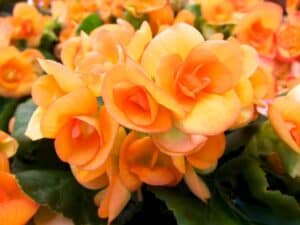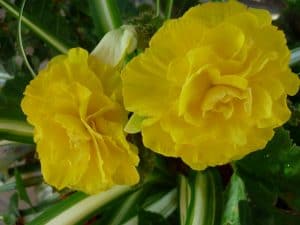What is Reiger Begonia?

Rieger Begonia, also known as begonia x hiemalis is s beautiful winter-flowering plants that have bright, creamy, and beautiful blooms. It is also sometimes called elatior begonia, although it is the same plant as the Rieger begonia.
This plant is known as a winter-flowering plant as they require cold temperatures and short days to bloom. If you make use of blackout curtains and temperature control, you can produce them year-round too. People grow Rieger begonia as houseplants. It requires airy, light, and fast-draining soil and bright but indirect light.
Rieger begonia flower varies in several colors like bright yellow, red, pink, salmon, orange, and even white.

How to grow Rieger begonia
- Select a cool place that remains dark in the evening, for shorter days and longer nights. Keep the plant away from the illumination of streetlights because it might disrupt the cycle. Place it in an east or west-facing window so that it will get sunlight for only part of the day.
- Provide temperatures between 60 to 70 degrees Fahrenheit during the day, and 50 to 60 degrees Fahrenheit at night.
- Water the plant only when the soil feels dry. Do not overwater.
- Avoid splashing the leaves in the evening. It might cause ugly water spots as well as fungus diseases.
- During the blooming period, fertilize your plant once a month with a high-phosphorous liquid plant food. However, when it stopped blooming, do not feed the plant.
- Cut back the stem to 3 inches and allow it to dry for six weeks.
- Water the plant regularly so that new shoots will begin to appear at its base. When new shoots appear and reach 3 inches tall, remove the lower leaves and put them in a damp in mixture of half sand and half peat moss.
- Make sure that the soil covers at least one node on each and invert a plastic bag loosely over their pot. It helps to maintain humidity.
- After a month, remove the plastic bag and check if the cuttings have hardened off.
- If you wish to retain the original plant, leave a few shots on the old plant and repot it in a slightly bigger pot
- If you want to transplant the cuttings, you need to prepare African violet potting mix in a 6-inch pot for three cuttings. Pinch back the tips of the cuttings when they become able to establish, to encourage them to branch out. Feed them monthly with high-phosphorous plant food.
Here is a video on How to Propagate Begonias by yourself
How to care Rieger begonia?
- To care for the plant, only you need is a proper lightning condition, an adequate temperature, adequate fertilization, and transplantation of the plant when needed.
- For this plant, you need a cold and dark place. A temperature that ranges from 60 degrees F to 70 degrees F during the day and from 50 degrees Fahrenheit to 60 degrees Fahrenheit at night.
- Feed the plant once a month with a high-phosphorous liquid plant food. During the fall, you need to keep your old plant and new cuttings in a protected place until the cooler temperatures and shorter days cause them to set buds again.
- However, do not move the plant to a new position after it has begun to flower because it might cause it to shed buds.

When do Rieger Begonia bloom?
If the temperature is maintained, the flower bloom around the year.
Uses of Begonias
- Begonia flower is often used as an ornamental plant because it has a red color flushed and beautiful shape.
- People use it as cold medicine. You can use the flowers by boiling them, then strain, and drink the water regularly to gain its benefit.
- Begonia also contains anti-bacterial so the flu can heal quickly.
- Eating begonia flowers are good for your digestive system. It helps to cure nausea, vomiting, and diarrhea.
- Rieger begonia is good for bone and teeth growth and treats bronchitis. It brightens the skin too.
- It acts as a rheumatic remedy and natural cough medicine.
- Similarly, begonia flowers help to stop the bleeding, relieve asthma symptoms, and treat dysentery.
Possible side effects
- Rieger Begonias are susceptible to mildew.
- Begonias contain oxalic acid that might be harmful to the people who have a kidney problem. Therefore, before the consumption of this flower, you need to consult a doctor and follow his prescription.
FAQ Section
Can Rieger begonias take full sun?
All begonias prefer some shade, so too much sunlight can damage them. That is why you should completely avoid direct sunlight. You can get away with some direct sun for the first few hours of the day, but you should be sure to provide plenty of shade during these times.
Is a Rieger begonia a perennial?
yes, How many flowers can Rieger begonias produce?
Begonias are perennials, but only if you keep them in pots or containers. The bigger size of these plants makes them much more manageable in containers.
Do you deadhead Rieger begonias?
Usually, we do not deadhead Rieger begonias. If we do, we do it in the early fall while they are still quite small and before the new growth starts. We like to clip off the spent blooms and let them dry out and die out.
How long do Rieger begonias last?
These plants are known to grow up to 7 months.
How often should I fertilize my Rieger begonia?
Begonias, as a whole, are not known for their big appetite. However, you can fertilize with a slow release fertilizer from spring through the fall. In the summer months, you can mist water several times a week with a plant mister. This will deliver the needed nutrients to the plant without overloading it.
Where can I buy Rieger begonia seeds or plants?
Store like Amazon and Home Depot have Rieger begonia plants as well as seeds for sale. They make charge you a few dollars to ship but the flower is worth buying.

Amelia is a plant and nature lover! Ever since she was little, she loved spending time in her family’s garden and learning about how to care for each plant individually. As an adult, she has dedicated herself to sharing what she has learned and continuing to expand her knowledge on the plant kingdom.
